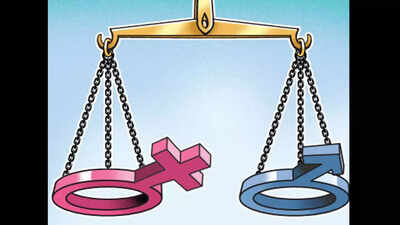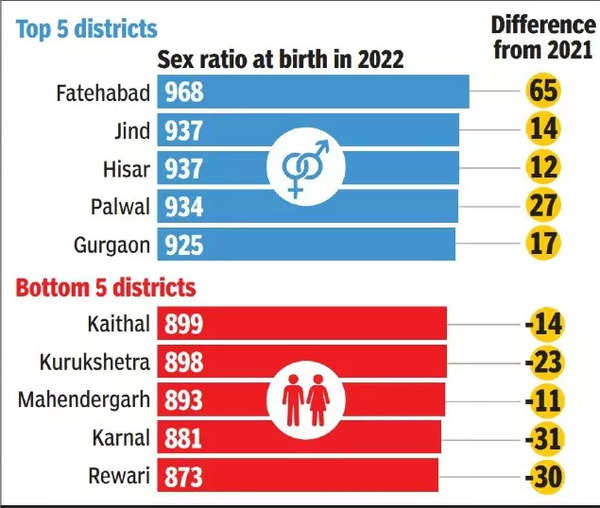- News
- City News
- gurgaon News
- Sex ratio at birth up 2% from last year in Gurugram
Sex ratio at birth up 2% from last year in Gurugram

Representative image
GURUGRAM: The city has improved its sex ratio at birth (SRB) in the past year, according to health department data, which says that 925 girls were born for every 1,000 boys in 2022 – an increase of 17 percentage points, or 2%, from the 908 SRB recorded in 2021.
The district’s performance is in line with that of the state. Data released on Sunday also showed that Haryana – known for its skewed gender gap – had improved its SRB to 916 this year, compared to the 914 in 2021.
Officials said the rise in SRB can be attributed to the district’s enforcement drives against prenatal diagnosis of gender.
 “So far, we have filed 35 cases this year under the Pre-Conception and Pre-Natal Diagnostic Techniques Act. Some of the accused were operating in different states as well. Our teams have been conducting raids in Delhi, Rajasthan and Uttar Pradesh to curb incidents of sex determination. Our doctors are also spreading awareness. As a result, Gurugram’s position has moved upwards in the SRB chart. We are hopeful about seeing more improvement in the coming months,” chief medical officer Virender Yadav told TOI.
“So far, we have filed 35 cases this year under the Pre-Conception and Pre-Natal Diagnostic Techniques Act. Some of the accused were operating in different states as well. Our teams have been conducting raids in Delhi, Rajasthan and Uttar Pradesh to curb incidents of sex determination. Our doctors are also spreading awareness. As a result, Gurugram’s position has moved upwards in the SRB chart. We are hopeful about seeing more improvement in the coming months,” chief medical officer Virender Yadav told TOI.
The number of FIRs filed in Gurugram under PC-PNDT Act has risen over the past few years. In 2021, about 21 such cases were registered; the figure was 14 in 2020 and just one in 2019.
However, SRB results across the state vary.
About 10 of the total 22 districts in Haryana showed a downward trend in SRB. This includes Kurukshetra (898), which showed a 23-point fall from 2021 and Panipat, which saw a 10 percentage point decline from 918 in 2021 to 908 this year.
The worst performing districts for 2022 are: Rewari (873), Karnal (881), Jhajjar (888), Faridabad (893), Mahendergarh (898), Charkhi Dadri (918), Nuh (925) and Kaithal (899). All of these districts saw SRB fall in the past year. The districts with the highest SRB in the state are: Fatehabad (968), Palwal (934), Gurugram (925), Jind (937) and Hisar at (937).
Across India, Haryana was among the states with the worst sex ratio figures. According to the 2011 census, the state had the lowest child sex ratio of 834 compared to the national average of 919. It has, however, seen steady improvement in SRB over the past few years.
In 2015, its SRB was 876, which rose to 900 in 2016, followed by 914 in 2017. It remained the same in 2018, and increased to 923 in 2019, followed by 922 in 2020, data by the central government shows.
Experts said that taking strict action against sex determination practices plays an important role. “The government needs to further strengthen the PC-PNDT Act and strong legal action need to be taken against illegal abortions. Awareness drives are crucial,” said DV Sahran, former director of health services, Haryana.
The district’s performance is in line with that of the state. Data released on Sunday also showed that Haryana – known for its skewed gender gap – had improved its SRB to 916 this year, compared to the 914 in 2021.
Officials said the rise in SRB can be attributed to the district’s enforcement drives against prenatal diagnosis of gender.

The number of FIRs filed in Gurugram under PC-PNDT Act has risen over the past few years. In 2021, about 21 such cases were registered; the figure was 14 in 2020 and just one in 2019.
However, SRB results across the state vary.
About 10 of the total 22 districts in Haryana showed a downward trend in SRB. This includes Kurukshetra (898), which showed a 23-point fall from 2021 and Panipat, which saw a 10 percentage point decline from 918 in 2021 to 908 this year.
The worst performing districts for 2022 are: Rewari (873), Karnal (881), Jhajjar (888), Faridabad (893), Mahendergarh (898), Charkhi Dadri (918), Nuh (925) and Kaithal (899). All of these districts saw SRB fall in the past year. The districts with the highest SRB in the state are: Fatehabad (968), Palwal (934), Gurugram (925), Jind (937) and Hisar at (937).
Across India, Haryana was among the states with the worst sex ratio figures. According to the 2011 census, the state had the lowest child sex ratio of 834 compared to the national average of 919. It has, however, seen steady improvement in SRB over the past few years.
In 2015, its SRB was 876, which rose to 900 in 2016, followed by 914 in 2017. It remained the same in 2018, and increased to 923 in 2019, followed by 922 in 2020, data by the central government shows.
Experts said that taking strict action against sex determination practices plays an important role. “The government needs to further strengthen the PC-PNDT Act and strong legal action need to be taken against illegal abortions. Awareness drives are crucial,” said DV Sahran, former director of health services, Haryana.
FOLLOW US ON SOCIAL MEDIA
FacebookTwitterInstagramKOO APPYOUTUBE
Start a Conversation
end of article









